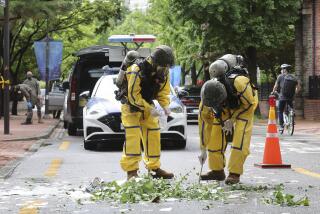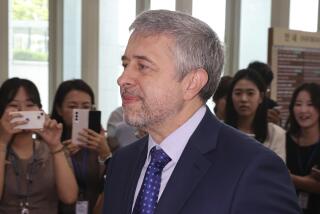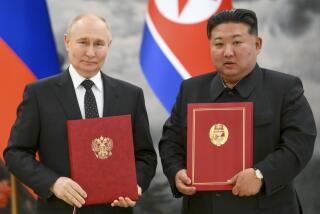How to Turn the Copter Tragedy Into Korean Peace
WASHINGTON â Just as the recent nuclear accord with Pyongyang was raising hopes that an easing of tensions on the Korean Peninsula might be on the horizon, a U.S. military helicopter that had un wittingly strayed into North Korea was downed and an American airman killed. Republicans were quick to renew their criticism of the accord. But the incident also serves as a grim reminder of the still ominous North Korean conventional-military threat.
North Korea claims it shot down the Army helicopter, which was on a training mission, after its pilot ignored warning shots. The remains of the dead pilot have been returned, but a surviving airman is still in North Korean custody, though Pyongyang has promised his release.
North Koreanâs initial truculence--first ignoring requests for information, then delaying the return of the captured soldier and Army helicopter--exasperated U.S. officials. Secretary of State Warren Christopher went so far as to admonish Pyongyang that failure to resolve the matter swiftly could imperil nascent efforts to open formal U.S.-North Korea relations. For its part, North Korea says it is âinvestigatingâ the incident, but its procrastination may have more to do with tensions within the still uncertain Pyongyang leadership, perhaps between the military and civilian elites, than with its determination to uncover facts.
Nonetheless, the Clinton Administrationâs early response to the crisis left much to be desired. Even as Pyongyang was releasing the body of the dead airman, Pentagon spokesman Dennis Boxx said, âI donât think weâre at the apology stage yet.â Excuse me. Does being the sole superpower mean never having to say youâre sorry?
While some details of the incident remain murky, there is no doubt that the copter intruded into North Korean territory. For that, we owe Pyongyang an apology. Indeed, given the stakes, the United States should have dispatched a senior official to Pyongyang to offer one and resolve the affair. But fearful of being perceived by congressional Republicans as âsoft,â the Administration diplomatically mistepped.
This sort of arrogance is virtually guaranteed to evoke the worst in the always contentious and paranoid North Koreans. Giving North Korea face is important in the always difficult task of eliciting their cooperation; humiliating them will usually ensure the opposite.
Unfortunately, President Bill Clintonâs overall policy toward North Korea has one of lurching from crisis to crisis without a clear sense of strategy. Then, a combination of U.S. generosity, North Korean desperation and luck resulted in the Pyongyangâs promise to dismantle its nuclear-weapons program in exchange for a basket of goodies, including shipments of heavy oil and two light-water reactors to replace its dismantled facilities. At a projected cost of some $4 billion, the nuclear project will be chiefly financed by South Korea and Japan, through a new international consortium known as KEDO (Korean Energy development Organization).
The helicopter imbroglio, however, points up the dangers of the Administrationâs preoccupation with the nuclear issue: It is ignoring North Koreaâs conventional-military threat. The country maintains a million-man army, on which it spends 25% of its gross domestic product; some 70% of it is deployed within 60 miles of the DMZ, along with about 11,000 artillery tubes and Scud missiles.
It may thus be said that the nuclear issue is the easy part of the problem. The hard part is the question of North-South reconciliation, a process that is now stalemated. Indeed, conceptualizing the nuclear problem as a U.S.-North Korea matter served only to increase North-South tensions, while deepening resentment in South Korea.
There is no sign yet that the Administration has a policy to deal with this larger issue. When questioned, senior U.S. officials say only that we have âother concernsâ--ranging from human rights and Pyongyangâs missile sales to the conventional-force issue--that will âbe addressed in the context of normalization.â
But the helicopter episode offers an opportunity to build on the nuclear accord and begin to discuss revising the 41-year armistice. For starters, the truce village at Panmunjom is ill-equipped to handle the growing volume of North-South traffic. Now, it is mostly congressmen. When the United States opens a liaison office in Pyongyang next year, it will be U.S. officials. Then, it will be growing numbers of South Korean businessmen who will be planning, designing and building the light-water reactors. The United States and South Korea would be wise to sit down with Pyongyang and negotiate a âCheckpoint Charlieâ crossing point at Panmunjom to facilitate this traffic.
Moreover, along with China, a signatory to the armistice) and the two Koreas, we should begin to discuss a peace treaty. Those negotiations should include a schedule for a pullback of North Korean forces from the DMZ. And if North Korea really wants South Korean, Japanese and Western investment, U.S. and Japanese embassies and membership in international financial institutions, these objectives should provide leverage for the West to foster North-South reconciliation. A major goal should be deep conventional-force reductions of North and South Korean forces similar in scope to those embodied in the Conventional Forces in Europe arms-reduction accord.
But as the helicopter episode illustrates, we are a long way from easing achieving such goals. In the meantime, the Korean Peninsula remains perhaps the worldâs most dangerous tinderbox.
More to Read
Sign up for Essential California
The most important California stories and recommendations in your inbox every morning.
You may occasionally receive promotional content from the Los Angeles Times.










